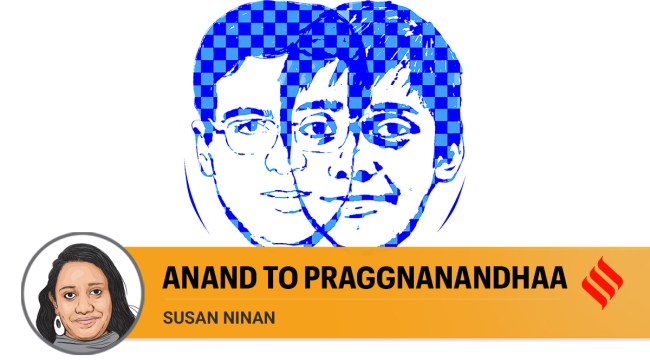Opinion Praggnanandhaa’s journey: What it takes to be a global chess star
More than what the young Grandmaster's second-place at the chess world cup means in isolation, it is a signpost of how far he and his fellow Indian players have travelled
 Indian Grandmaster R Praggnanandhaa during the second tie-breaker match of the Chess World Cup 2023 final against Norwegian Grandmaster and World No. 1 player Magnus Carlsen, in Baku. (PTI)
Indian Grandmaster R Praggnanandhaa during the second tie-breaker match of the Chess World Cup 2023 final against Norwegian Grandmaster and World No. 1 player Magnus Carlsen, in Baku. (PTI) Praggnanandhaa may not feel it just yet. But what he’s done at the World Cup in Baku over the past four weeks is a tectonic, seminal, throw-in-the-thesaurus big deal. Both for him and Indian chess. And it wasn’t just him.
Praggnanandhaa turned 18, crossed 2700 Elo, made a World Cup final and qualified for the Candidates — the latter will determine the challenger for the World Championships. Ordinarily, all of this doesn’t happen in the space of a few weeks. It’s a breakout moment for the game in the country. With his casual genius and goofy smile, the teen may seem not to make a big deal out of this. He may even be hurting a smidgen from the loss in the final tiebreaks against world No 1 Magnus Carlsen. More than what this result means in isolation, it is a signpost of how far he and his fellow Indian players have travelled.
The Indian’s run to the final – defeating two of the world’s top three players apart from fellow Indian Arjun Erigaisi — has left Indian chess fans gasping. No one saw it coming. Last year, he was the online chess disruptor who defeated Carlsen three times in a row. On paper, Praggnanandhaa was not supposed to go beyond Round 4, against second seed Hikaru Nakamura at this World Cup. When the match moved to tiebreaks, the American speed chess monster was supposed to be the favourite. Nakamura was gobsmacked that not only did he lose, but the Indian didn’t even allow him a glimmer of hope.
He always wanted to get here. When I met Praggnanandhaa at his home in Padi, a west Chennai suburb, in December 2017, he was not yet a Grandmaster (GM). He was the youngest International Master then. His answer to what he wanted to become was surprisingly not Grandmaster — the title he was actually chasing then. “World champion, the highest-rated player,” he said in a heartbeat.
For generations of Indian players, five-time world champion Viswanathan Anand was the reason they picked up, played, and considered chess as a career option. Anand grew up in a different time, as an outsider in the Soviet-dominated game. The choice of leaving his Chennai home and moving to Europe in the early 1990s was a pragmatic one. It was the only way to become a successful professional player. Access to resources, training and tournaments then hinged on geography — talent alone wasn’t enough. Proximity meant visibility and invitations to play more tournaments.
For Indians players who arrived on the scene even two decades after Anand, access to regular training under a GM was almost inconceivable. Anand’s former second, Surya Sekhar Ganguly, who turned GM in 2003, had his first-ever GM interaction right before he himself turned one. Russian Yevgeniy Vladimirov was visiting India for a coaching camp and it turned out to be a moment of epiphany for Ganguly. He realised that he stood on the brink of becoming a GM with a tenuous grasp of even basic rook-pawn endgames. Things began to turn when the GMs who believed they’d run their course as players began switching to coaching early. Most often, the decision was brought about by a lack of funds to travel abroad and compete regularly. With the world opening up, access to technology and materials was no longer the preserve of the few.
What India has on its hands now is a pleasant problem of strength in numbers at the top.
Initially, Praggnanandhaa didn’t get an invite to this year’s Tata Steel tournament in Wijk Aan Zee. One of the most prestigious and oldest chess tournaments in the world known to bring in promising talents alongside the best names, felt there was no room to have a third Indian player in the mix. D Gukesh and Arjun Erigaisi — who were then ranked higher than Praggnanandhaa — had already found their places in the Masters section. Praggnanandhaa’s coach R B Ramesh wrote to the tournament organisers, requesting that they consider his student at least for the Challengers section, where typically up-and-coming junior players compete. Praggnanandhaa was unaware of any of this unfolding. By late November last year, he finished third in a stacked Champions Chess tour online event that Magnus Carlsen won. An invite to play alongside Carlsen in the Masters section at Wijk Aan Zee followed.
The pandemic was a pivot. Over-the-board tournaments came to a standstill and it left players to their devices. Suddenly, they had nowhere to go and a whole lot of time to prepare.
Today, the country has three players under 20 — Praggnanandhaa, Gukesh and Erigiasi — in the top 30. Nihal Sarin, also part of this promising teen pack, figures not too far below. Gukesh sits a spot above Anand at No. 8 in the live ratings. Anand, now a semi-retired player, Fide deputy president and mentor, doesn’t mind the tidal wave of youth taking over. If anything, he’s helping engineer this transition through the WestBridge Anand Chess Academy where all these young players find mentorship, in addition to their private training routines.
India has 83 GMs now. Six new GMs have already arrived this year. Its regularity almost makes it seem like an unremarkable feat. The playing numbers have risen sharply and there are more Indian players at the top than ever before. This World Cup has been a preview of what possibly lies ahead.
For those who haven’t made it big yet, every tournament arrives with the question of how long their families can punt on their dream. Take someone like Daakshin Arun, who has a remarkable live Elo rating of 2427, the highest in the Indian Under-14 group. His father quit his job as a college lecturer to accompany him to tournaments in India and abroad. His mother does the heavy lifting of being the sole salaried member of the family. There are no sponsors yet, and they have their backs to the wall.
Praggnanandhaa’s parents — Rameshbabu and Nagalakshmi — have been a touch luckier with support. They often had to borrow money to keep Praggnanandhaa and his sister, Vaishali, in chess. At least till one of them did something outrageous enough for help to arrive. In 2016, Praggnanandhaa became the world’s youngest International Master at 10 years, 10 months and 19 days. Soon after, a sponsor agreed to take care of the siblings’ chess expenses. Within two years of becoming IM, he became the second-youngest GM in the world (today he’s the fifth).
Between Anand and Praggnanandhaa, much has changed in Indian chess. Yet much remains the same.
In the absence of proper support structures, it’s still a bunch of plucky parents who’ve quit jobs, put chess above school for their kids, taken mortgages on their homes, and are travelling to tournaments with their 8-15-year-olds hoping funds will outlast their dreams. Praggnanandhaa, with his gutsy run to the final, is perhaps the hope they needed to hold out a little longer.
The writer is a journalist and has co-authored ‘Mind Master’ with Viswanathan Anand






